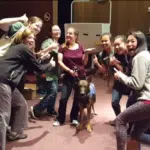
Written By Amie Chapman
COVID19 has affected almost everyone around the world.
This includes the service dog industry. The industry has felt major effects from the current situation, and I predict that it will take multiple years for the industry to fully recover. Some people have been affected directly, and some indirectly. People have lost lives, jobs, income, a sense of security, and so much more. We have no idea yet what the long term impact this pandemic will cause, but the world will be in a recovery period for awhile.
Recent stories have circulated where service dog organizations have been closing their operations to people receiving their service dogs. This is due to the complications of the pandemic. Many organizations have service dog users come to their campus for training and matching with their prospected service dog candidates. COVID19 has caused more than a few problems. People with life challenges who could benefit from a service dog are less likely to be able to get a dog at the moment. This includes new service dog handlers, and handlers that are in need of a successor dog to replace a dog that is in need of retirement.
This also means that there will be a number of dogs waiting to be placed with more dogs also in the pipeline. A stoppage in the regular flow of dogs may result in trainers not being able to keep up with the current number of dogs coming through their programs. Most organizations try to plan for a certain number of dogs at each stage of their training program which requires a coordinated effort spanning many months with many moving parts.
With the placement of dogs slowing down, paused for a period of time, or halted altogether, it has caused a ripple effect all the way down the training line. Now we are at a the point that some organizations have halted or slowed the number of puppies being bred. Some have even begun releasing dogs that might otherwise make it as service dogs because they are unable to get them to people who need them. The fact is that it takes about 2 years for a service dog to mature from a baby puppy to a fully trained dog for service work. So if the number of puppies being bred now is decreased, that means two years from now there will be a lot less mature dogs ready for placement. The number of people needing a service dog will be the same or increased in two years, and a lot fewer dogs available.
As for the organizations that are still placing dogs; most of them are doing it with decreased numbers.
It is going to take much longer than usual to get the trained dogs placed. It is going to take much longer than usual to get through the list of people waiting. With most organizations having a wait time of 1-5 years for service dogs, it makes me wonder how much more wait time will be added on as the waiting period increases.
Another thing we have observed is the impact Covid19 has had on puppies that have recently started the training process. The good news is the number of service dog puppy raisers seems to be holding. With more people staying home it appears there are people willing to take on the duties of having a puppy. But these pups are being raised in a much different manner at the moment. Not an ideal one. It has been common for organizations to send out their puppies to volunteer raisers who start taking these puppies out in public. This is how the puppies get accustomed to all types of settings like the mall, the movies, and the city park.
The service dogs in training (SDIT) need practice getting comfortable in all types of settings.
With many areas having a shelter in place order, some organizations have also implemented protocols to keep puppies at home. Some are even restricting dogs from going to the few places that are open for business. This means puppies are not getting comfortable with all types of settings. They are not getting exposed to the sights, sounds and smells of grocery stores. They’re not learning to navigate shopping carts and other shoppers. They are not getting used to learning to lay quietly under a table in loud, busy restaurants. They are not learning how to ride public transportation. Many other training opportunities are being left behind.
Covid19 is also affecting the service dog organizations that have prison programs.
Many of the prisons are currently closed to any visitors of any kind. This means that the puppies inside the prisons are not getting rotated out like they usually do. This also means that representatives from the organizations are not allowed to go to the prisons to evaluate and see how the service dog puppies are progressing.
As places begin to reopen, and raisers are allowed to take puppies for public training opportunities…
how will this generation of puppies respond? Will they have no issues? Will they do just fine in a public setting? Will they have a few fear issues that can easily be worked through? Will the organizations be releasing more dogs than usual from their program because the dogs can’t adjust and handle the stress of working in public? If dogs are unprepared it could cause an even bigger shortage of trained dogs available for placement in the future.
Now, many training scenarios can be duplicated without being in public.
Raisers can practice having the puppy lay under the dining table at home during meals. A raiser can have a person with a cart on wheels practice by walking the puppy by it. However in the end, it is very hard to create all aspects of a public atmosphere that a dog needs to be comfortable with.
Public transportation is just one area that cannot be recreated in a shelter in place scenario. All it takes to be released from service may be stress, or uncomfortableness with certain situations. I have known puppies that are comfortable in every aspect of a grocery store, except they are uncomfortable walking by refrigeration units. Or other puppies are fine with crowds, and almost all noises, but very uncomfortable with overhead speakers. My point; without taking puppies and dogs in training through all types of scenarios, we won’t know if they have any sensitivities to things. A service dog recipient doesn’t want to discover these sensitivities after they have become a team. It is important to know these things before a dog is placed with someone.
Another issue that service dog organizations are dealing with is funding.
They are taking a huge hit. For example; Matt told me that Brigadoon Service Dogs has already anticipated a 30% drop in fundraising from their 2020 fall Gala coming in September. This is because it is going to be online for the first time. It is also because of the uncertainty of the economic times. Most organizations are 501(c)3 and rely on donations from foundations, individuals, and businesses to support their communities. With people out of work, and the economy headed into a recession, less donations will be coming in for the organizations. Also, events aren’t being allowed to be held. All in person fundraisers like dinners, auctions, speaking events, galas, and concerts have been cancelled. These are usually the biggest revenue makers for organizations.
When donations are at risk for a period of time, there will be a reduction in the number of dogs produced out of a program. Organizations won’t be able to afford to breed them, nor train them. For the smaller organizations it could mean closing their services all together. This will cause a ripple effect for the number of dogs available for people in the future. If social distancing is going to be continued, organizations may need to increase the number of trainers.
Instead of bringing in a group of people for training, some organizations are decreasing the group sizes. The are having the instructors do one on one training at their facilities. They are bringing the dogs to the recipients for in-home training. All of this adds to the time it takes to get these dogs placed, and the costs of getting these dogs to the recipients.
How can we help keep the service dog industry going?
Support them!
Follow them on social media to know what types of fundraising events they may be having. Many are having online auctions or fundraising campaigns. Eat out on that day. Many people are getting food to go and supporting causes that way. They may choose a restaurant, a particular day to eat out, and invite supporters to eat out for dinner. A percentage of the profits go to the service dog organization and everyone is happy. We encourage people to donate directly if possible; even if it is a small amount.
Many organizations have wish lists for items. See if you can help with purchasing items they need.
Raise a puppy! With so many people at home, it may be a new option for some people.
Most important! Don’t forget about the small organizations. So many people donate to the large organizations because they are well known. But remember; it isn’t the size of an organization that makes it important, but the people that they assist. There are many small organizations that make a huge impact on the lives of the people they serve. They are just as deserving to receive help as the large organizations that produce hundreds of service dogs a year. In our research we have found smaller organizations are more likely to train a customized dog for individuals with multiple disabilities. A small organization may be more likely to offer multiple task training too. Do your research because it is important to keep all this in mind. Find an organization that serves a mission that is true to your heart. True to your beliefs. There are so many different types of service dogs out there now, and each organization is built to help different types of disabilities. Small or large; they are all important, and need our help.
We here at Growing Up Guide Pup are working on some new outreach programs.
These are solutions that will be helping service dog users, and organizations. Our Service Dog Litter Project is just one way we’ll be trying to assist other service dog organizations. With the help of the community, we will produce a litter of puppies for deserving organizations. Some organizations are unable to absorb the costs of breeding, and whelping a litter of pups. Other organizations are unable to purchase puppies from carefully screened bloodlines. We want to help. We can help make an impact for multiple organizations by providing pups, media exposure and audience growth. We plan to continue the fourth season of our series with this litter. We plan to promote the project to festivals all over the globe… as we introduce people to service dog culture. Please pick from our boutique of outreach programs and support the one that speaks to you. Please help us out! Even a small donation can make a big impact when many people do the same action on a massive scale.







